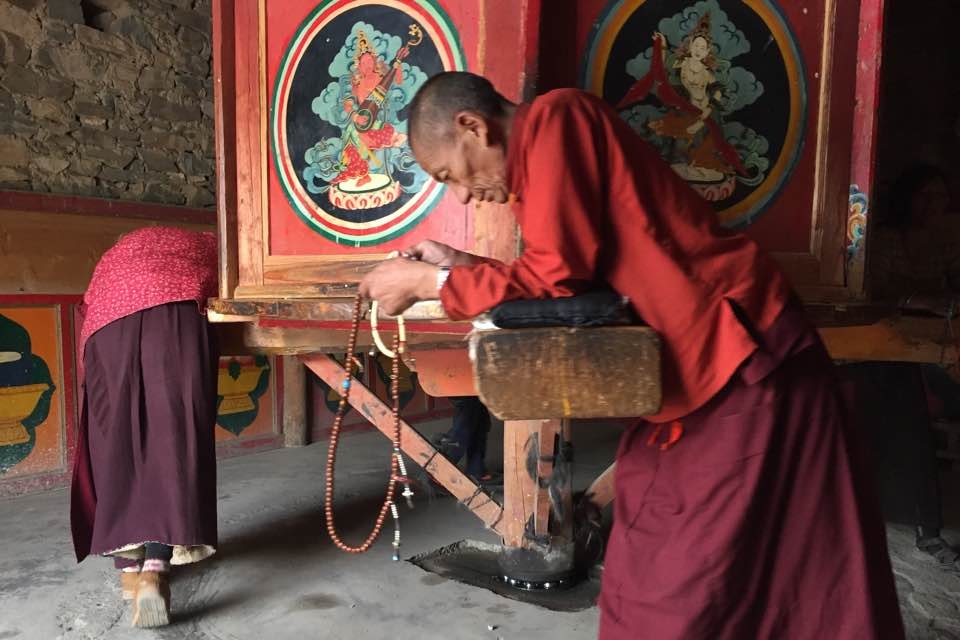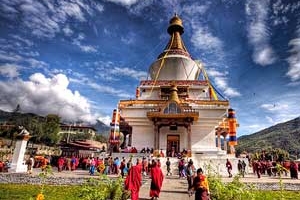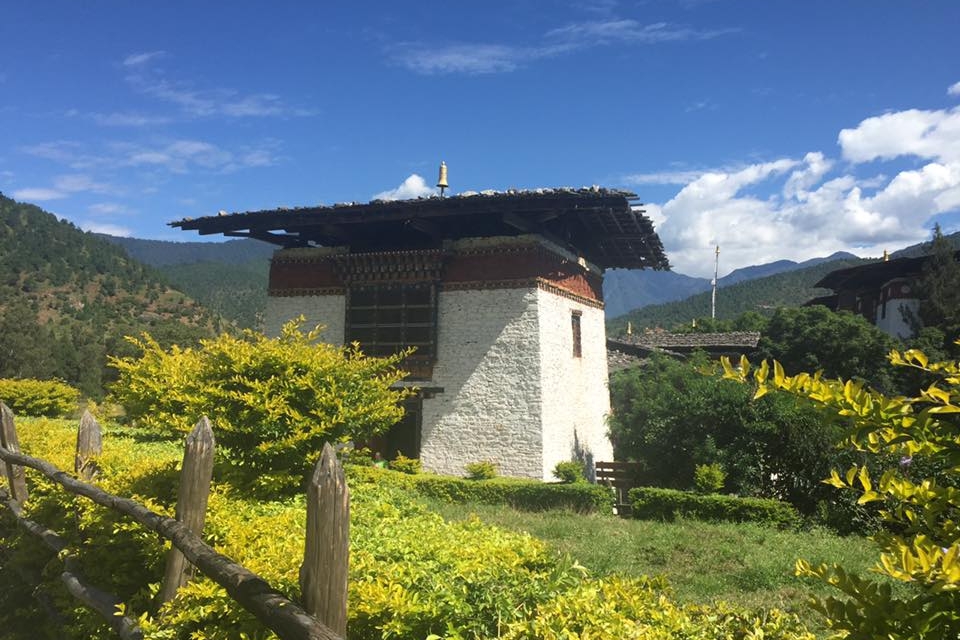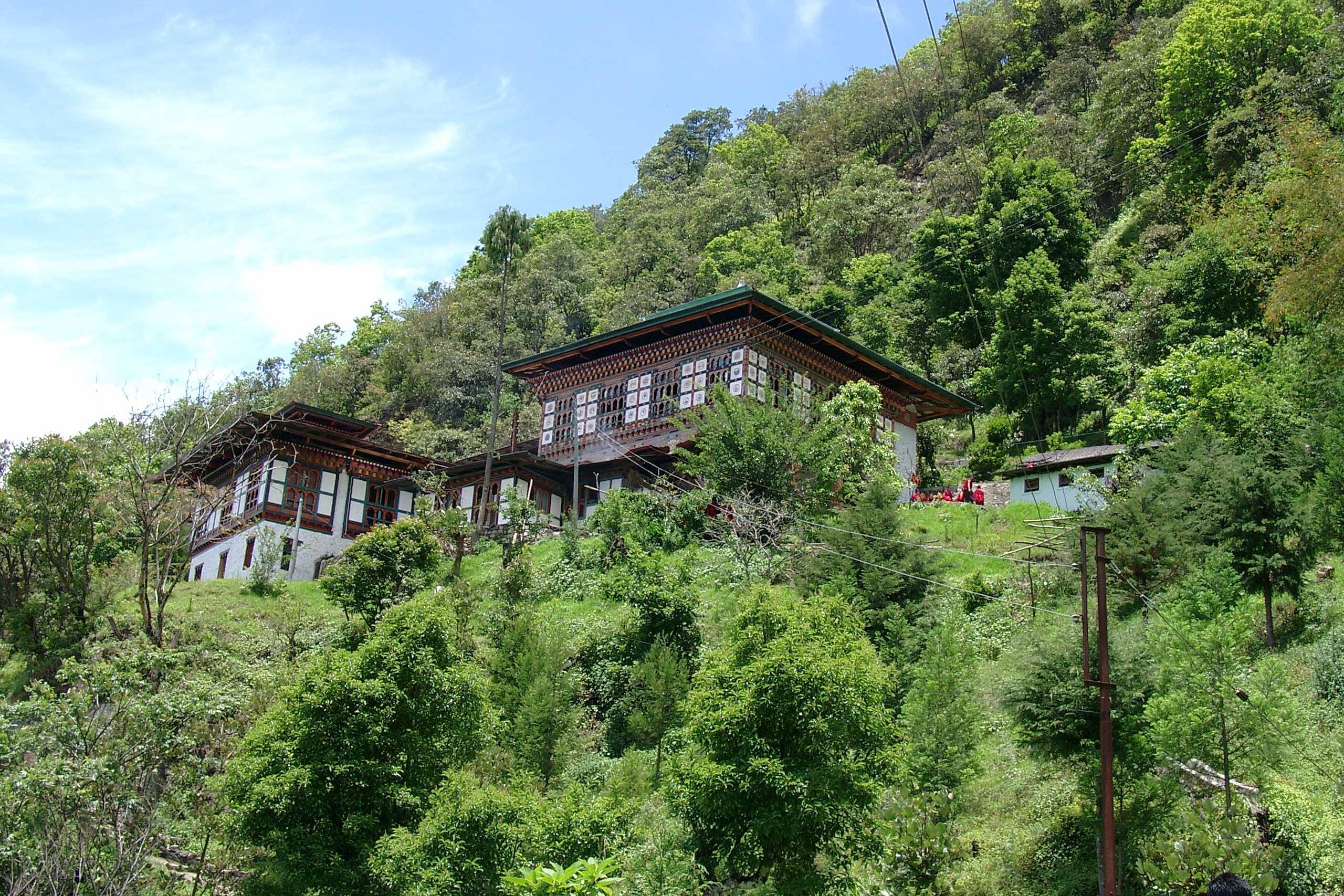Embarking our tour, we fly over to the dragon kingdom Paro. We fly over passing by Mountains of 5500 meters to Paro. Paro is a beautiful valley and is home to many of Bhutan’s oldest monasteries and temples, and the country’s only international airport. The flight to Paro is one of the most spectacular mountain flights in the world, with a constantly changing panorama of some of the highest mountains on earth including Chomolhari and Jitchu Drake peak. Paro Airport has been described as “the most difficult commercial airport in the world”. 1980meter runway length presents a double challenge, due to the extremely low density altitude at the site. So, only a handful of well experienced pilots are certified to operate commercial airplanes here thus, making least number of flights in a day. After immigration and custom formalities, check out from the departure lounge. There you will meet one of the representatives of Nature Trail Travels & Tours, Trekking & Expeditionwho will greet you and then escort you to your respective hotel where you will stay overnight. Before lunch, at the hotel there will be an orientation on Bhutanese etiquette by your guide.
Then we will visit Rinpung Dzong, meaning ‘fortress of the heap of jewels’to see the painting of the great saint Milarepa, considered as the master of meditation by the Bhutanese and believed to have attained enlightenment in a lifetime. The Dzong is now used as an administration center and school for monks. Dzong’s are large monasteries and district administrative centers, which were once strategic forts.Next, we visit Kichu Lhakhang, the oldest temple in the country. From here we will be taken to the Drugyal Dzong (Bhutan Victory Fort), which was built in 1646 to commemorate Bhutan’s victory over Tibetan invaders during the 1600s. On a clear day we can see Mount Chomolhari, Bhutan’s second-highest mountain, at 7,314meters. Overnight in Paro.



On this day, we drive for about two hours to reach Haa Valley, a steep north-south valley with a narrow floor. Haa valley lies on the Haa District along the western border of Bhutan. An alternative name for the district is “Hidden-Land Rice Valley”. Enroute we come across Chele La Pass (3810 m). The pass is dotted with colorful Buddhist prayer flags and offers stunning views of Mount Chomolhari and the valley below.We hike further down the pass to the Kila Gompa Nunnery, which is perched precariously along the rock face. Next, walk for a few miles through coniferous forests before driving downhill towards the picturesque Haa Valley. The valley is a narrow plain land sandwiched between two steep mountains. It is an awesome place to spend your time in peace away from the hustle bustle of the cities. This palace also has the ability to turn you speechless when the sun sets in the most amazing part of Haa Valley.



Explore around the valley for few hours. Haa valley is not so frequented by tourists and is a real hidden gem. This is an ideal place to spend your time in peace, take a river side walk and go out for hiking. Indian armies have a large base here and there is a small township around this army base. The Dzong in the Indian army premises is one of the attractions and worth a visit. The area is extremely well maintained with a small well-manicured mini golf course. Just in one side of the market you will see a majestic conical green covered hill. The breath taking views of the Haa valley is something a nature lover will always cherish. There are tons of birds, beautiful flowers and humongous mountains to look at. For the photographers, this place offers a wide range of 360 degree panoramic shots. After a short sightseeing tour around the valley, we drive to Thimphu, the capital of Bhutan. The ride is pleasurablethrough beautiful villages and pine forests. After passing Dobji Dzong, our trail descends and joins the main road at Chhuzom. We can stop here and enjoy watching local farmers sitting by the roadside and selling vegetables, apples and dried cheese. Continuing our drive further, we reach Thimphu for our overnight stay.



After appetizing breakfast, we will proceed for full day sightseeing tour in Thimphu. Initially, we start our sightseeing tour with a visit toNational Memorial Chorten. This temple was first initiated by the Third King as a protection from the negative elements of modernization, and as a monument to world peace. The Royal Queen Mother completed it as a memorial Stupa for the Third King who passed away in 1972. Then we will continue our visit to 12th century Changangkha Temple and Drubthob monasteryhousing the Zilukha Nunnery. If you want to see Takin, the national animal of Bhutan then you can proceed onto mini-zoo. The Takin (a goat-antelope) was declared the national animal of Bhutan because it is strongly associated with the country’s religious history and mythology. After sightseeing of these sites, if you still have some time left then you can visit to National Library, the priceless collection of Buddhist manuscripts and few English version books; Folk and Heritage Museum, which displays day to day livelihood of typical Bhutanese farmers in medieval period and their accessories; Late King’s Memorial Stupa, built for the world peace and Traditional Handmade Paper Factory; Painting School, which preserves our traditional paintings, sculpturing and wood curving and National Handicraft Emporium, the best place to look for souvenir from Bhutan. You can also visit the Rinpung Dzong, meaning ‘fortress of the heap of jewels’ to see the painting of the great saint Milarepa, considered as the master of meditation by the Bhutanese and believed to have attained enlightenment in a lifetime. The Dzong is now used as an administration center and school for monks. Dzong’s are large monasteries and district administrative centers, which were once strategic forts. Some of the landmarks are closed on the weekend (Saturdays and Sundays). Therefore, if your visit to Thimphu coincides with the weekend, you can walk through the Thimphu Market to see the variety of food of Bhutan, including basket upon basket of fiery chilies, cheese and a variety of greens. (This market is open only from Friday-Sunday). After a full day sightseeing tour in Thimphu, we further drive to Punakha, valley famous for the massive amount production of crops and fruits.



After breakfast, we set out on a scenic drive to Punakha with a stop at Dochu La pass (3,100m), where on a clear day we can get spectacular views of the Himalayas. From the pass, we drive downhill through rhododendron, fir and hemlock forests. We stop at Lobesa and hike through rice paddies to Chimi Lhakhang temple. This temple is dedicated to Drukpa Kuenley, or the ‘Divine Madman’, who is believed to bless women who seek fertility. After reaching Punakha, we visit the Punakha Dzong, which is situated between the male and female rivers like an anchored ship. Overnight in Punakha.



Punakha is another wonder place to visit in the Kingdom of Bhutan which is blessed with a beautiful climate and has the natural drainage from its rivers Pho Chhu; which is considered to be a male river and Mo Chhu; which is called as a female river. After breakfast, we begin our hike to a village connected by the longest suspension bridge in Bhutan. The major attraction point in Punakha is the Punakha Dzong which was built in 1637 A.D. at the junction point of Pho Chhu and Mo Chhu rivers. This Dzong was built to serve as a religious and administrative center of the region.The Dzong is open for the visitors during the Punakha festival and in the summer months when the monks move to Thimphu.The views from the bridge of the nearby mountains and the river below are breathtaking. We walk on a leveled trail along the Mo Chu River and come to a local village where we tour farmhouses and meet families who may offer you a cup of butter tea or an “ara” which is a local wine made of wheat or rice. Later in the afternoon, we can hike further to KhamsumYulleyNamgyel Chorten, a delightful 3-story Chorten that looks down on the upper Punakha Valley. The views of the valley and the surrounding snow-capped mountains are stunning. Overnight in Punakha.



After breakfast, we drive to Paro via Dochu La pass. There, we visit the new Druk Wangyal Monastery. With elaborate paintings depicting the lineage of the present monarchy and their visionary works, the Druk Wangyal Monastery is the only one of its kind in the country. After the tour of the monastery, we continue our drive with a stop in Thimphu for lunch. Overnight in Paro.



On the eight day of our tour, we will have a short hike up to Taktsang monastery. Taktsang is a prominent sacred Buddhist site and temple complex perched on the edge of upper Paro Valley. It is also known as the Tiger’s Nest. This magical monastery clings to a vertical granite cliff 300 meter above the valley.Legend has it that the great Guru Padmasambhava flew to this spot on back of a tigress and meditated in a cave during the 8th century. When the Guru finished his meditation, he instructed that the monastery to be built. The temple was built around the cave and is a hallowed shrine for Bhutanese pilgrims.The spectacular view along the way and the historical sites draw many tourists to this imposing monastery. There are also a number of temples scattered along the route. Later we’ll turn to the Paro Dzong, a large Buddhist monastery and fortress, which is considered the best example of Bhutanese architecture. Now it also houses the district Monastic Body and government administrative offices. On the hill above the Dzong stands an ancient watchtower called Ta Dzong, which is the National Museum of Bhutan. Visit Ta Dzong Museum housing many religious relics, works of art and handicrafts offering a great orientation into Bhutan’s historical, cultural, and religious past.This Dzong was converted into the National Museum in 1968. The museum boasts antique thangkas, textiles, weapons and armor, household objects and rich assortment of natural and historic artifacts.Here you can also learn about Bhutan’s history.



After early breakfast, we drive to Phuntsholing, a border town in southern Bhutan. It is also the administrative seat of Chukha District of Bhutan. The town lies opposite the Indian town of Jaigaon, and cross-border trade has resulted in a thriving local economy. The six hour long drive is beautiful, and we will see some waterfalls along the way. Overnight in Phuntsholing.


Concluding our trip, we drive out of Phuntsholing for our next destination. In this way, our 10 days Himalayan Kingdom tour comes to an end. Hope you enjoyed your tour and will get back very soon.





Discover incredible offers for your upcoming adventure by subscribing to our newsletter with the latest travel tips and updates.
